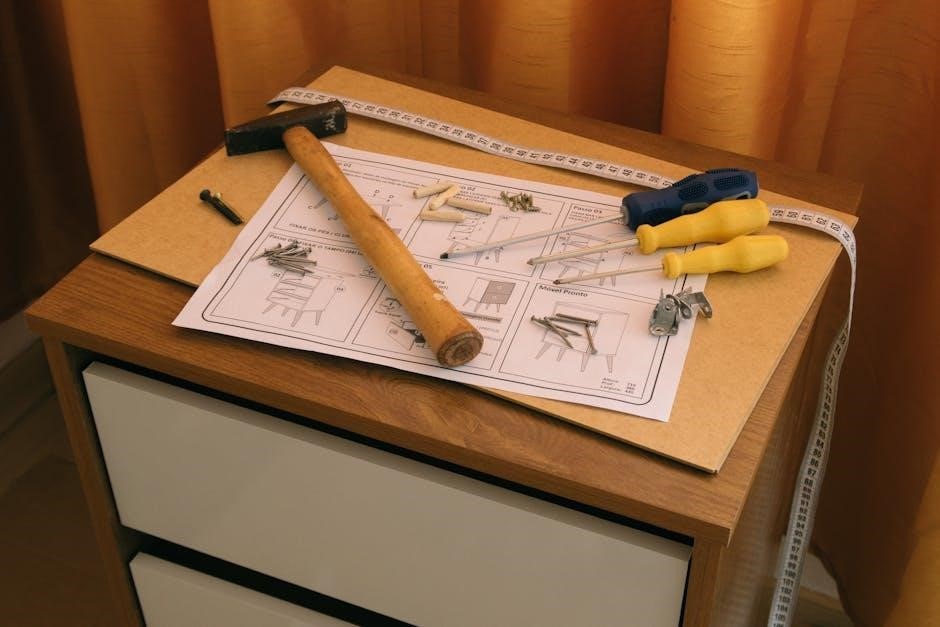Self-cleaning GE ovens offer a convenient way to maintain cleanliness by using high heat to burn food residue, leaving ashes that are easy to wipe away. While some users praise the efficiency, others caution against potential risks like damage to modern models and high energy costs. Always follow manufacturer guidelines for safe and effective cleaning.
Overview of Self-Cleaning Technology
Self-cleaning technology in GE ovens uses high heat to burn food residue, turning it into ash that’s easy to wipe away. This process eliminates the need for harsh chemicals, but modern models have faced criticism for potential damage from extreme temperatures. Some users praise the convenience, while others warn of risks like melted circuit boards. The feature works by locking the oven door and heating to around 880°F, requiring proper preparation like removing racks and ensuring the oven is empty. Despite controversies, it remains a popular option for effortless cleaning, though manual methods are often recommended for lighter maintenance. Always follow guidelines to avoid damage.
Benefits of Using a Self-Cleaning Oven
Self-cleaning ovens offer convenience, efficiency, and time savings. The high-heat cycle eliminates tough food residue without manual scrubbing, making maintenance easier. This feature also reduces the need for harsh cleaning chemicals, creating a safer environment. Additionally, self-cleaning ovens promote healthier cooking by removing baked-on grime that can affect food taste. While energy consumption during cleaning is high, the long-term cost savings and reduced effort make it a valuable option for busy households. Modern models have addressed past concerns about damage, ensuring a reliable and efficient cleaning process.

Understanding the Self-Cleaning Process
The self-cleaning process uses high heat to burn food residue into ash, which is easily wiped away after cooling. The oven door locks during cleaning for safety.
How the Self-Clean Feature Works
The self-clean feature works by heating the oven to extremely high temperatures, typically between 800°F and 1000°F, to burn food residue into ash. This process is initiated by selecting the self-clean option on the control panel, which automatically locks the oven door for safety. The intense heat breaks down tough grime and food particles, making them easy to wipe away once the cycle is complete and the oven has cooled. This method is efficient and reduces the need for harsh cleaning chemicals, but proper ventilation is essential to prevent odors and fumes from spreading in the kitchen.
Temperature Levels During Cleaning
Different GE oven models may have varying temperature levels during the self-cleaning cycle. Typically, the oven heats to between 800°F and 1000°F to effectively incinerate food residue. These high temperatures ensure that tough grime and stains are reduced to ash. The exact temperature may depend on the model and cleaning mode selected. Always refer to the user manual for specific temperature ranges for your appliance. Proper ventilation is crucial during this process to prevent the buildup of fumes and odors in your kitchen.
Duration of the Cleaning Cycle
The self-cleaning cycle duration varies depending on the oven model and the level of soil. Typically, it ranges from 2 to 4 hours. Light cleaning modes may take less time, while heavy-duty cycles require longer periods. Always refer to your GE oven’s manual for specific cycle times. It’s important to allow the oven to cool completely before wiping away ash. Ensure the oven is empty except for racks, and avoid interrupting the cycle once it starts. Proper planning ensures effective cleaning without delays or safety risks.

Safety Precautions for Self-Cleaning
Always ventilate your kitchen during the self-cleaning cycle to prevent harmful fumes. Never use the oven during cleaning. Keep children and pets away for safety.
Warnings for Ovens Manufactured After 1980
For ovens manufactured after 1980, high heat during self-cleaning can release fumes from food residue. Proper ventilation is essential to avoid inhaling harmful particles. Avoid using abrasive cleaners, as they may damage the oven’s finish. Always use oven mitts or tongs to handle racks after cleaning, as they remain extremely hot. Never leave the self-cleaning process unattended. For models with a lock feature, ensure the oven door is securely closed to prevent accidents. Keep pets and children away during the cleaning cycle. Follow manufacturer guidelines to avoid damage or safety hazards.
Appliance Technician Recommendations
Appliance technicians recommend regular light cleaning after each use to prevent heavy grime buildup, which can make self-cleaning less effective. Avoid using harsh chemicals, as they may damage the oven’s interior or harm the self-cleaning elements. Always remove oven racks before the cleaning cycle to prevent discoloration. After the cycle, wipe away ash with a damp cloth to avoid streaks. For optimal results, follow the manufacturer’s instructions precisely. Additionally, technicians suggest scheduling professional maintenance annually to ensure the oven operates efficiently and safely. This helps extend the appliance’s lifespan and performance.
Ventilation Requirements During Cleaning
Proper ventilation is essential during the self-cleaning cycle to remove harsh fumes and odors. Open windows and ensure excellent airflow in the kitchen. Turn on exhaust fans or use a ventilation hood to circulate air effectively. Avoid using air fresheners, as they can react with cleaning fumes. Keep the kitchen well-ventilated throughout the cycle to prevent lingering smells. If possible, close adjacent rooms to contain odors. Follow the oven’s manual for specific ventilation recommendations, as models may vary. Proper airflow ensures a safer and more efficient cleaning process.

Preparation for Self-Cleaning
Remove racks and accessories, clean heavy grime, and protect the kitchen from heat. Ensure the oven is empty and surfaces are clear for optimal cleaning.
Removing Oven Racks and Accessories
Before activating the self-cleaning feature, remove all oven racks, shelves, and accessories. These items can warp or discolor due to high temperatures. Place them in soapy water for cleaning. Ensure the oven is completely empty, as utensils or cookware may obstruct airflow or create fumes. For specific rack removal instructions, consult your GE oven manual. This step ensures the self-cleaning process is unimpeded and prevents damage to accessories. Clean racks separately with mild detergent and rinse thoroughly before reinstalling after the cycle completes.
Protecting the Kitchen from Heat and Odors
When using the self-cleaning feature on your GE oven, it’s essential to protect your kitchen from excessive heat and strong odors. Start by ensuring proper ventilation—open windows and turn on your exhaust fan to high speed. Consider using an air purifier to minimize lingering smells. Keep doors to adjacent rooms closed to prevent odors from spreading. Wearing gloves and a mask can help if you’re sensitive to fumes. For natural odor absorption, place a bowl of vinegar or baking soda near the oven. Finally, follow GE’s guidelines for optimal ventilation and safety during the cleaning cycle.
Pre-Cleaning Heavy Grime and Food Residue
Before activating the self-cleaning feature, remove large food particles and grime from the oven floor and walls using a plastic scraper or soft brush. Wipe surfaces with a damp cloth to eliminate loose debris. This step ensures the self-cleaning cycle works efficiently. Avoid using harsh chemicals, as they can damage the oven’s finish. For stubborn stains, apply a paste of baking soda and water, let it sit, then wipe clean. Removing racks and accessories during pre-cleaning prevents them from getting damaged by high heat.

Using the Self-Cleaning Feature
Activate the self-cleaning mode by selecting the appropriate setting on your GE oven’s control panel. Choose the cleaning cycle based on soil level: light, medium, or heavy. Ensure the oven is empty and preheated as instructed for optimal results.
Step-by-Step Activation of the Self-Clean Mode
To activate the self-clean mode on your GE oven, start by ensuring the oven is cool and empty of racks and accessories. Press the “Clean” button on the control panel to select the self-clean option. Use the arrow keys to choose the cleaning cycle duration based on soil level: light (1-2 hours), medium (2-3 hours), or heavy (3-4 hours). Once selected, press “Start” to begin the cycle. The oven door will lock automatically for safety. Ensure proper ventilation in your kitchen, as fumes may be released during cleaning. Avoid being in the room during the cycle due to potential odors. The oven will emit a noise during operation, which is normal. After completion, allow the oven to cool before wiping away ash with a damp cloth. Always follow manufacturer instructions for optimal results and safety.
Understanding Different Cleaning Modes (Clean, Prolonged Clean, Heavy Duty Clean)
GE ovens offer three cleaning modes tailored to different levels of grime. The “Clean” mode is ideal for light food residue and takes about 1-2 hours. “Prolonged Clean” is designed for moderate buildup and runs for 2-3 hours, ensuring deeper cleaning. The “Heavy Duty Clean” mode tackles tough, baked-on grime and requires 3-4 hours. Each mode adjusts temperature and duration to effectively remove residue without damaging the oven. Choose the mode based on soil level for optimal results. This feature ensures efficient cleaning while preserving energy and oven longevity.
Monitoring the Cleaning Process
Monitoring the self-cleaning process is essential for safety and efficiency. The oven door locks automatically during cleaning due to high temperatures, so avoid opening it. Check the display for time remaining and progress indicators. You may hear clicking or knocking sounds as food residue burns off. Strong odors and smoke are normal but ensure proper ventilation. Stay nearby to address any issues, like unusual smells or excessive noise. Do not leave the oven unattended. Once the cycle ends, let the oven cool before wiping away ash; Keep children and pets away during the process for their safety.

Post-Cleaning Procedures
After the cycle, let the oven cool completely before wiping away ash with a damp cloth. Clean racks and exterior separately for a polished finish.
Cooling Down the Oven After Cleaning
Allow the oven to cool completely after the self-cleaning cycle, which may take 2-3 hours depending on the model. Keep the oven door closed during this time to ensure even cooling. Once cooled, the oven light will typically turn off, indicating it’s safe to proceed. Avoid opening the door prematurely, as residual heat can cause burns. Use oven mitts when handling the door or racks. Always refer to your specific GE oven model’s manual for exact cooling times, as they may vary slightly. Proper cooling ensures safety and prevents damage to the oven’s interior surfaces.
Wiping Away Ash and Residue
After the self-cleaning cycle and cooling period, open the oven door and carefully remove the racks. Use a damp cloth or sponge to wipe away the ash and residue from the oven walls and floor. Avoid using abrasive cleaners or scrubbers, as they may damage the finish. For tougher residue, a soft scouring pad can be used gently. Wipe the window with a glass cleaner for clarity. Dispose of the ash and residue properly, and rinse the racks thoroughly before replacing them. Regular wiping prevents residue buildup and maintains the oven’s appearance and performance. Always wear gloves to protect your hands during this process.
Cleaning the Oven Racks and Exterior
Remove the oven racks and wash them with soap and warm water. For tough grease, soak them in a sink or large container. Use a soft sponge or brush to scrub away residue. Rinse thoroughly and dry before reinstalling. For the oven exterior, wipe with a damp cloth and mild detergent. Avoid abrasive cleaners to prevent damage to the finish. Regular cleaning prevents grime buildup and maintains the oven’s appearance. For stainless steel exteriors, use a microfiber cloth and stainless steel cleaner for a streak-free finish. This ensures the oven looks new and operates efficiently.

Energy Consumption and Cost
Self-cleaning GE ovens use significant energy during cycles, but they are designed to optimize efficiency. Costs vary based on electricity rates and usage frequency.
Electricity Usage During Self-Cleaning
Self-cleaning GE ovens consume significant electricity during the cleaning cycle due to high temperatures. A typical cycle uses around 2-3 kWh of energy, depending on the model and duration. The oven heats to extreme temperatures (up to 900°F) to burn off food residue, which requires substantial power. This high energy usage can temporarily increase your utility bill. However, GE ovens are designed to optimize efficiency during self-cleaning. It’s recommended to run the cycle during off-peak energy hours to minimize costs. Always check your local electricity rates to estimate the exact impact on your bill. Modern models are more energy-efficient than older ones.
Estimated Energy Costs for a Cleaning Cycle
The estimated energy cost for a self-cleaning cycle in a GE oven depends on your local electricity rate. On average, a cleaning cycle uses 2-3 kWh of electricity, costing between $0.25 to $0.50 per cycle, based on a national average of 12-15 cents per kWh. In areas with higher electricity rates, costs can reach up to $1.00 per cycle. To calculate your specific cost, multiply your kWh rate by the energy consumed during the cycle. Running the cycle during off-peak hours can help reduce expenses. Modern GE ovens are designed to optimize energy use, but costs may still vary depending on usage frequency and local rates.
Timing the Cycle for Optimal Energy Use
Timing your self-cleaning cycle can significantly impact energy efficiency. Run the cycle during off-peak hours when electricity rates are lower to reduce costs. GE ovens often have adjustable cycle lengths, allowing you to choose shorter cycles for lighter messes, which saves energy. For heavier cleaning needs, opt for longer cycles but ensure they are necessary. Additionally, some GE models feature smart sensors that adapt cleaning time and temperature to minimize energy use. By aligning your cleaning schedule with energy-efficient practices, you can optimize both cost and performance.

Alternatives to Self-Cleaning
Explore alternatives like manual cleaning, steam cleaning, or professional services to maintain your GE oven without using the self-cleaning feature, saving energy and time effectively always.
Manual Cleaning Methods
Manual cleaning is a straightforward alternative to self-cleaning ovens. Start by removing racks and accessories, then mix baking soda and water to create a paste. Apply it to interior surfaces, avoiding heating elements. Let it sit overnight before wiping down with a damp cloth; For tougher grime, vinegar can be used to scrub and neutralize odors. This method is gentle on surfaces and avoids harsh chemicals or high temperatures, making it a safer, eco-friendly option for maintaining your GE oven’s cleanliness without the self-clean feature.
Using Oven Cleaning Chemicals
Oven cleaning chemicals are a popular alternative for tackling tough grime and food residue. These products typically come in sprays or gels and are designed to break down stubborn stains. Always wear gloves and ensure good ventilation when using chemicals, as fumes can be harmful. Apply the cleaner according to the product instructions, let it sit for the recommended time, and wipe clean with a scrubber or cloth. While effective, these chemicals can be harsh on skin and surfaces, so caution is essential. This method is a good option for those who prefer not to use the self-cleaning feature but still want a deep clean.
Steam Cleaning as an Alternative
Steam cleaning offers a gentle and eco-friendly alternative to traditional cleaning methods. By using water and heat, steam loosens food residue without harsh chemicals. This method is ideal for lighter messes and regular maintenance. Simply place a bowl of water in the oven, heat it to create steam, and let it sit before wiping clean. Steam cleaning is energy-efficient and avoids strong fumes, making it a safer choice for families. However, it may not tackle heavy grime as effectively as the self-cleaning feature. For tougher stains, combining steam with light scrubbing can enhance results while maintaining a chemical-free approach.
Maintenance and Troubleshooting
Regularly inspect and clean oven racks, and check for worn-out seals. Address error codes promptly and ensure proper ventilation. For persistent issues, consult a certified technician.
Regular Maintenance Tips for Self-Cleaning Ovens
Regular maintenance ensures optimal performance of your self-cleaning GE oven. After each use, wipe down the interior with a damp cloth to prevent grime buildup. Inspect door seals for wear and tear, as damaged seals reduce cleaning efficiency. Avoid using abrasive cleaners, as they can damage the finish. Clean oven racks periodically by soaking them in hot soapy water. Run the self-clean cycle only when necessary, as frequent use can strain the oven. Always allow the oven to cool before cleaning to avoid burns. For tougher stains, mix baking soda and water for a gentle, non-abrasive scrub. Consult your user manual for specific care instructions.
Troubleshooting Common Issues
Address common issues with your self-cleaning GE oven to ensure smooth operation. If error codes appear, consult the user manual for specific solutions. A non-starting self-clean cycle may indicate a child safety lock engagement or incorrect settings. Odors during cleaning often result from leftover food residue; ensure thorough pre-cleaning. If the oven overheats, check for blocked vents or excessive food debris. For stuck doors post-cleaning, allow the oven to cool completely before opening. Avoid using harsh chemicals, as they can damage the oven’s finish. Refer to the troubleshooting guide in your manual for model-specific solutions to maintain efficiency and safety.

Additional Features and Considerations
GE self-cleaning ovens often include smart home integration, voice command compatibility, and energy-saving modes; Some models feature advanced cooking algorithms and customizable presets for enhanced convenience. Consider noise levels, LED lighting, and Wi-Fi connectivity for seamless operation. These features enhance usability while maintaining efficiency, ensuring a modern cooking experience tailored to your preferences and lifestyle demands.
Steam Clean Function in GE Ovens
The Steam Clean function in GE ovens uses water vapor to loosen food residue, making cleaning easier. Simply add water to the oven floor, select the steam clean option, and let the cycle run. This feature is ideal for light to moderate grime and reduces strong odors. Unlike the high-heat self-cleaning mode, steam cleaning is gentler on surfaces and requires less energy. After the cycle, wipe down the interior with a damp cloth for a sparkling finish. This eco-friendly option is perfect for maintaining your oven without harsh chemicals or extreme temperatures.
Child Safety Locks and Other Safety Features
GE ovens feature child safety locks to prevent accidental activation, ensuring safe operation. This feature can be activated manually or may automatically engage during cleaning. Additional safety features include automatic shut-off, which turns off the oven if it detects inactivity or an issue. Heat-resistant glass doors allow visibility without burns. Always supervise children near the oven, especially during self-cleaning cycles. Follow the manufacturer’s guidelines for locking and unlocking the oven to maintain safety. These features ensure a secure cooking environment while preventing unintended access or accidents.

Environmental and Cost Considerations
Self-cleaning GE ovens reduce chemical use and energy waste, offering eco-friendly cleaning. Energy-efficient models balance high-temperature cleaning with lower consumption, while long-term savings come from reduced maintenance and chemical use.
Eco-Friendliness of Self-Cleaning Ovens
Self-cleaning GE ovens are designed with eco-friendly features, minimizing chemical use and reducing waste. The high-heat cycle breaks down food residue without harsh cleaners, promoting a greener cleaning process. Energy-efficient models optimize power consumption during cycles, while advanced insulation reduces heat loss. This eco-conscious design supports sustainable household practices, aligning with environmental goals. Regular use of the self-clean feature can also extend the oven’s lifespan, reducing the need for frequent replacements and landfill waste. GE’s commitment to energy efficiency ensures these ovens meet modern eco-friendly standards while maintaining performance.
Cost Efficiency of Self-Cleaning vs. Manual Cleaning
Self-cleaning GE ovens offer long-term cost efficiency compared to manual cleaning. While manual cleaning requires frequent purchases of specialized cleaners and scrubbers, self-cleaning ovens reduce reliance on these products. The high-heat cycle minimizes heavy grime buildup, lowering the need for deep cleans. Although energy consumption during cycles is higher, the overall savings from reduced cleaning supplies and extended oven lifespan offset the cost. Additionally, self-cleaning ovens require less labor and time, making them a practical choice for busy households. Over time, this balance of convenience and efficiency makes self-cleaning ovens a cost-effective option for maintaining a clean kitchen environment.
Self-cleaning GE ovens simplify maintenance with efficient, high-heat cycles, ensuring a pristine interior while minimizing manual effort and chemical use, making them a convenient and practical choice.
Final Tips for Effective Oven Maintenance
For optimal performance, use the self-clean feature wisely, avoiding frequent cycles. Wipe spills promptly to prevent grime buildup. Regularly inspect and clean oven filters. Avoid harsh chemicals, as they can damage finishes. After cleaning, ensure racks are securely placed to prevent warping. Always follow manufacturer guidelines for maintenance and troubleshooting. By adhering to these practices, your GE oven will remain efficient, reliable, and in excellent condition for years to come.
To ensure optimal performance and longevity, always follow the manufacturer’s instructions for self-cleaning. Properly prepare by removing racks and shielding surfaces from heat. Choose the right cleaning mode based on soil level. Ventilate thoroughly to avoid fumes. After cleaning, allow the oven to cool before wiping away residue. Regular maintenance, like light cleaning between cycles, prevents grime buildup. Avoid harsh chemicals to maintain the oven’s finish. By adhering to these practices, you’ll maintain efficiency, safety, and cost-effectiveness while keeping your GE oven in pristine condition.




















































